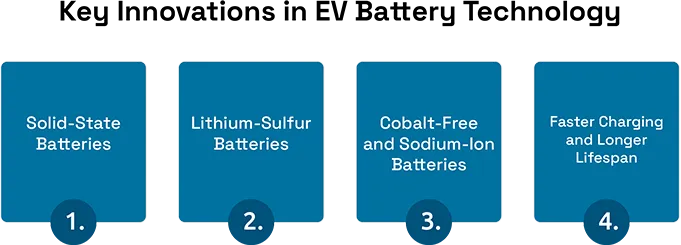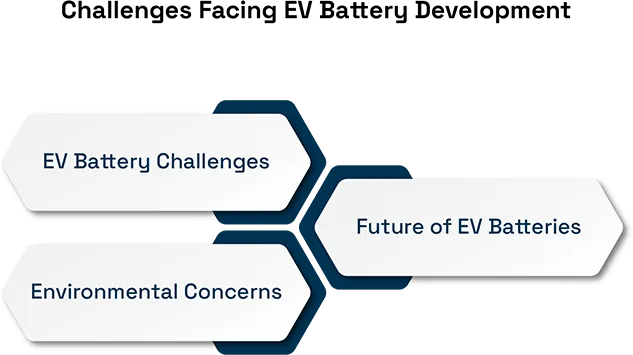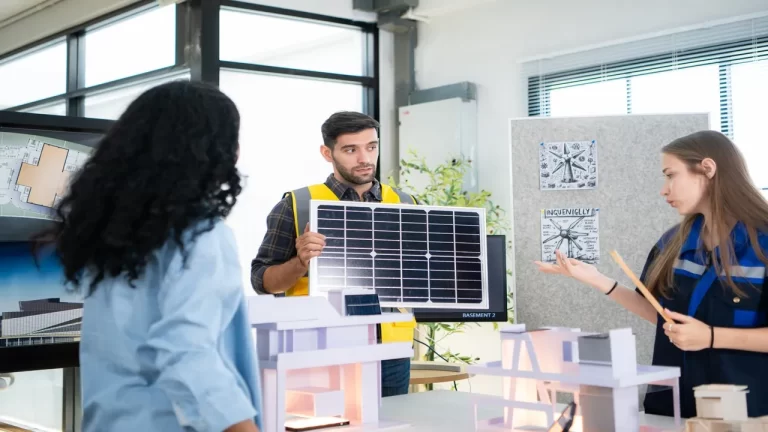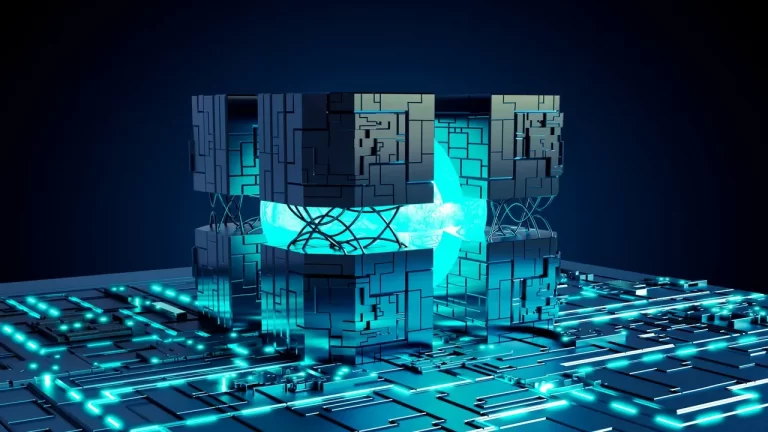The battery system supports vehicle driving power while storing saved energy. The lithium-ion power battery dominates as the primary battery because it leads the market through superior energy storage and high-tech performance. Lithium-ion batteries enable electrical power use for both battery-powered companies and individuals who depend on electric vehicles.
Multiple advanced battery innovations are being developed that achieve better capacity at reduced costs with environmentally friendly features. Developing batteries undergo solid-state batteries, lithium-sulfur batteries, and cobalt-free battery technology for better sustainability. The improved EV batteries will create a better electrical mobility system and protect our environment.
Key Innovations in EV Battery Technology
Solid-State Batteries
EV technology will use solid-state batteries as its next major development. The technology differs from lithium-ion batteries that require liquid electrolytes since it handle solid electrolytes. This update delivers three major advantages to battery technology: it supplies more stored energy per unit volume, speeds up charging times, and delivers enhanced protection. Big automakers, including Toyota and Samsung, plus researcher QuantumScape, dedicate resources to developing solid-state batteries for expanding EV accessibility. Using solid-state batteries removes liquid electrolytes, which makes heat problems and fire risks disappear naturally. Evolutionary vehicles operate more reliably and safely because of this improvement.
Lithium-Sulfur Batteries
Experts use Li-S batteries more often now because they can produce more energy than lithium-ion batteries do. They use sulfur in large amounts, which is inexpensive and benefits the environment. Until these issues are addressed, researchers cannot introduce Li-S batteries to general use. Researchers develop Li-S battery upgrades, including cathode and electrolyte designs, to enable technical success in EVs.
Cobalt-Free and Sodium-Ion Batteries
The use of cobalt in lithium-ion batteries creates problems because of how it is obtained and sent along the supply route. Research teams create battery alternatives without cobalt using lithium-ion and sodium-ion technology that runs more sustainably and economically with good results. Sodium-ion batteries use this energy like lithium-ion batteries, but with more accessible minerals that help eliminate rare mineral dependence. CATL and Faradion examine business opportunities to use sodium-ion batteries as a functional replacement.
Faster Charging and Longer Lifespan
Battery makers create faster charging methods through their product development. New battery technologies including silicon anodes and thermal management systems, let drivers enjoy longer battery life with faster charging times for EV acceptance. New BMS technologies manage battery charging better to keep the batteries working at peak levels over time.

Rising Mega-Trend of Electrification to Propel Market Growth
The fast replacement of gasoline-powered vehicles by electric ones strongly influences industry development. The global EV battery market will grow from EV adoption because governments work to build more EV charging stations in their systems. The original equipment manufacturers who produce vehicles are increasingly interested in expanding battery technologies, which support market development.
Major global automakers have declared detailed production growth plans for their electric models, plus additional model launches. Both BEV and PHEV car sales will need a dedicated charging system because these vehicles use lithium-ion batteries. EV growth with enhanced battery consumption will drive sales in every major market sector.
Challenges Facing EV Battery Development
Most lithium-ion batteries depend on limited supplies of lithium cobalt and nickel, which companies must source from areas with geopolitical risks. Companies seek deep-sea mining areas and battery recycling to make sure they get enough essential material despite supply chain issues.
Proceeding with battery recycling needs long-term support because it demands advanced management systems to succeed. Redwood Materials and Li-Cycle lead the industry by developing new methods to extract materials from used batteries, which decreases mining needs and protects the environment.
Building a state-wide EV charging system will make electric vehicles more acceptable to consumers. Governments and private charging companies put money into ultra-fast and wireless charging developments to erase range worries and improve EV usage as a viable transportation option.
Battery expenses still affect EV manufacturing companies, so they work to lower production prices. Upgraded energy storage methods and production networks combined with better battery science will make electric mobility more affordable and accessible.

The Future of EV Batteries
Progress in research and development will create future possibilities for EV batteries. Research into next-generation battery science and better energy storage technology combined with greener methods will accelerate progress. Private companies and public governments around the world are setting clear EV adoption plans that push battery innovation to progress faster.
The development of better EV batteries serves as a key element that helps advance electric mobility towards its environmental goals. New battery technologies emerging today will produce energy-efficient, cost-effective green transport solutions for the next transportation generation.
Electric Vehicle Battery Market Companies
Major car producers rely on battery supplies from CATL, Panasonic, LG Chem, BYD, and Samsung SDI. The leading companies participating in the EV battery industry include Johnson Controls and many additional main companies. Battery producers use their research money to develop better power storage solutions and make batteries last longer
Our market segmentation depends on battery type, functions, and geographical locations. Lithium-ion batteries have become dominant because they offer better results than lead-acid or emerging forms. BEVs and HEVs make up the market segments, but BEVs achieve higher sales numbers. North America, Europe, Asia-Pacific, Latin America, the Middle East, and Africa regions make up the industry, with Asia-Pacific ahead due to strong local EV production and sales.







